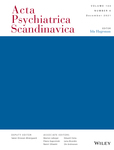Antidepressant-associated diagnostic change from major depressive to bipolar disorder
Abstract
Background
Anticipating diagnostic change from major depressive (MDD) to bipolar disorder (BD) can support better prognosis and treatment, especially of depression but is challenging and reported research results are inconsistent. We therefore assessed clinical characteristics associated with diagnostic change from MDD to BD with antidepressant treatments.
Methods
We compared characteristics of 3212 initially MDD patients who became (hypo)manic during antidepressant treatment to those with stable MDD diagnoses as well as with cases of stable, spontaneous BD, using standard bivariate and multivariate statistics.
Results
Among MDD patients, 6.69% [CI: 5.85–7.61] changed to BD, mostly type II (BD2, 76.7%). BD-converters had higher rates of familial mood disorders (74.1% vs. 57.1%) or BD (33.7% vs. 21.0%) and 2.8-years younger onset than stable MDD patients. They also had more prior depressive recurrences/year, years-of-illness, mood-stabilizer treatment, divorces, fewer children, more suicide attempts and drug-abuse, and higher intake cyclothymia, YMRS and MDQ scores. Predictors independently associated with diagnostic conversion were: more familial BD, depressions/year, unemployment, cyclothymic temperament, suicidal ideation or acts, and fewer children. BD-converters vs. spontaneous BD cases had significantly more suicide attempts, BD2 diagnoses, and affected relatives. Converting to vs. spontaneous BD1 was associated with more ADHD, more suicidal ideation or behavior, MDI course, and younger onset; converting to vs. spontaneous BD2 had more episodes/year, unemployment, ADHD, substance abuse, suicidal ideation or attempts, and more relatives with BD.
Conclusions
Few (6.69%) initially MDD subjects converted to BD, most (76.7%) to BD2. Independent predictive associations with diagnostic change included: familial BD, more depressions/year, unemployment, cyclothymic temperament, suicidal behavior and fewer children. Notably, several characteristics were stronger among those changing to BD during antidepressant treatment vs. others with spontaneous BD.

 求助内容:
求助内容: 应助结果提醒方式:
应助结果提醒方式:


